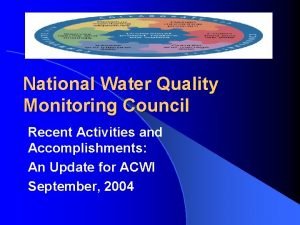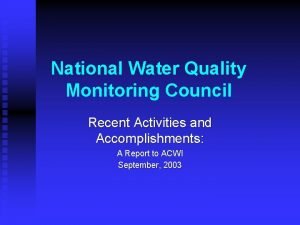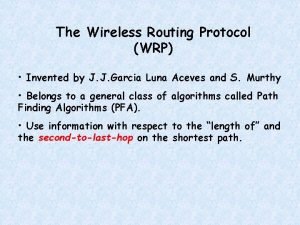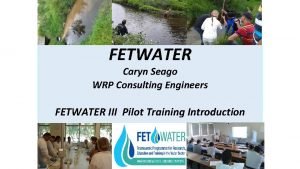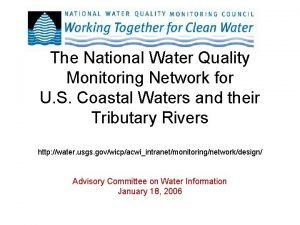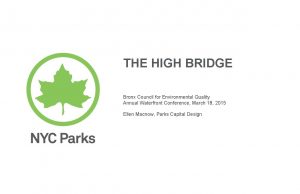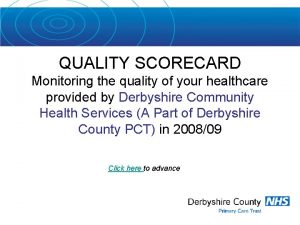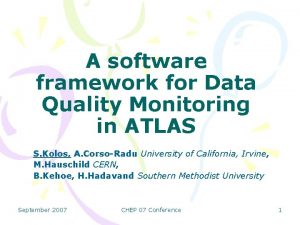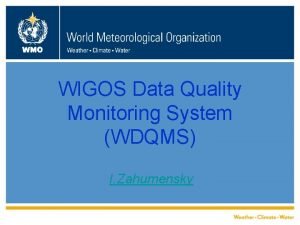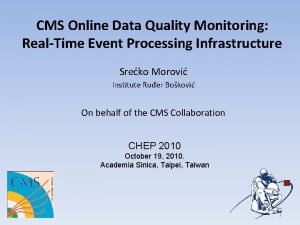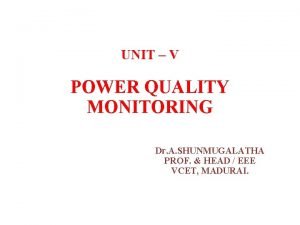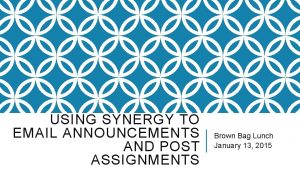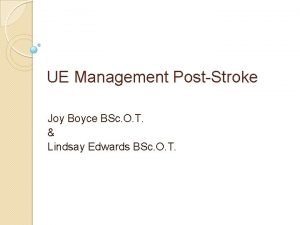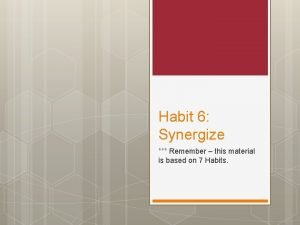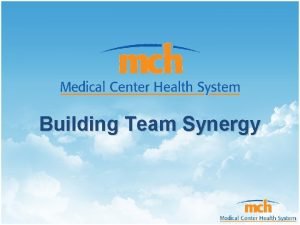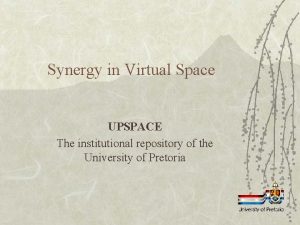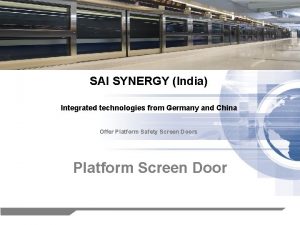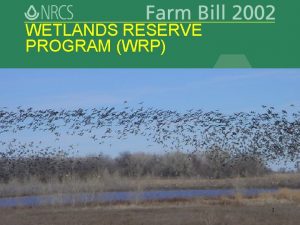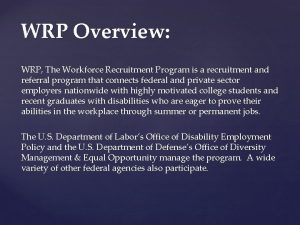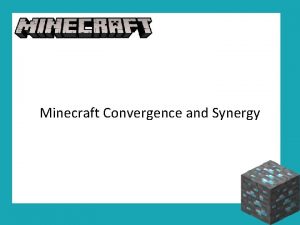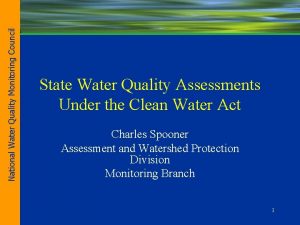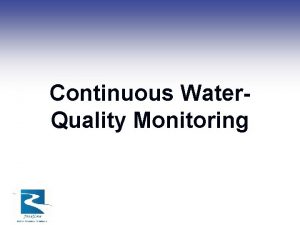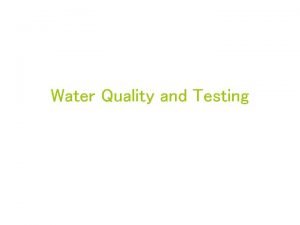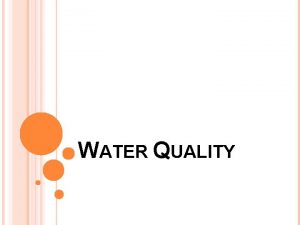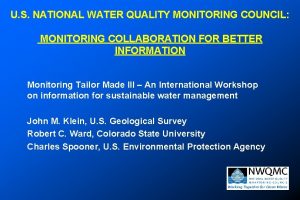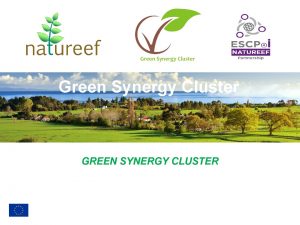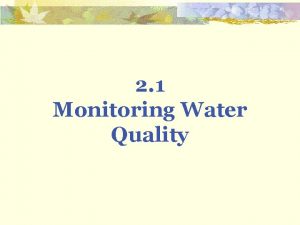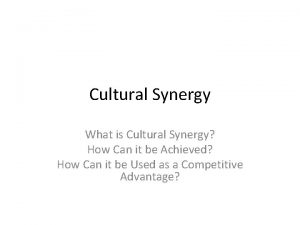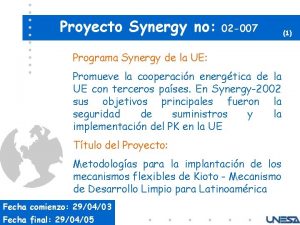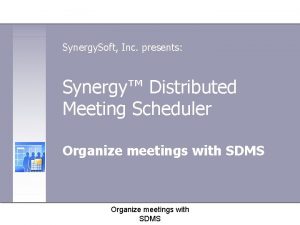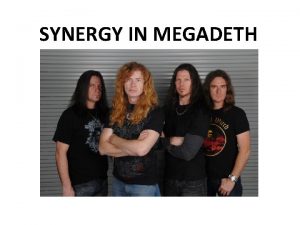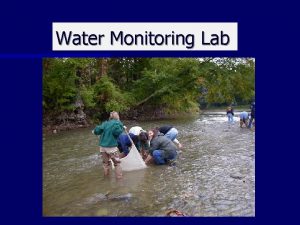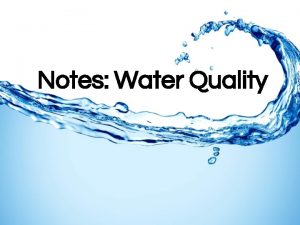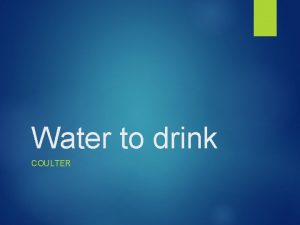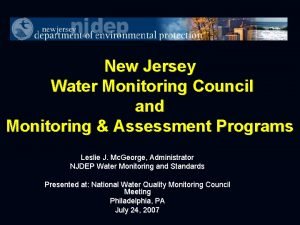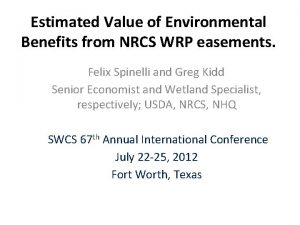WRP and Water Quality Monitoring Council Synergy Josh


























- Slides: 26

WRP and Water Quality Monitoring Council: Synergy Josh Collins Chief Scientist, SFEI and ASC Co-Chair, CWMW WRP Science Advisor Jon Marshack Executive Director, CWQMC April 1, 2015

Today’s Presentation • What is WRAMP? • Overview of selected tools – CARI, Eco. Atlas, Project Tracker, Landscape Profile, CRAM • How might WRAMP help the WRP?

Main Messages • Wetland protection requires coordinated work among multiple agencies at all levels of government. • Coordination is helped by common planning and assessment tools plus information sharing. • WRAMP can support the coordination that is needed by providing some of the needed technical tools.

WRAMP Overview

Water Quality Monitoring Council • SB 1070 in 2006 • MOU between CA EPA and CA Natural Resources Agency in 2007 SB 1070 and the MOU require the Council to: • recommend ways to improve coordination and costeffectiveness of water quality and ecosystem monitoring; • enhance the integration of monitoring data across departments and agencies; • increase public access to monitoring data and information.

California Wetland Monitoring Workgroup (CWMW) • 1 st of 8 Statewide workgroups of the Council. • Forum for Statewide coordination of wetland monitoring and assessment. • Mission is to develop WRAMP and support its use.

Tenets Wetland Riparian Monitoring Program (WRAMP) Reflects regional monitoring efforts including IWRAP

WRAMP Framework Regulatory or Management Decisions & Questions • • Ca Aquatic Resource Inventory (CARI) Status and. Conceptual Trends Program (S&T) Develop Models of Condition Cause & Effect Riparian Zone Estimator Tool Landscape Tool. Needed (more later) Identify. Profile & Classify Data Using USEPA System Projects, Landscapes Level 3: Intensive Assessment of Selected Aspects of Condition Special Studies of Methods & Hypothesis Testing Targeted or Probabilistic Sampling Design • Ca Rapid Assessment Method (CRAM) 1 -2 -3 Data 2 Framework • Level Riparian Assessment Tool CA Data • SF Bay Regional Wetland Monitoring Management Program Level 1: Inventories & Metrics • maps Bay-Delta Interagncy Regional Data based on and remote data Ecological Program Centers, BIOS • Santa Monica Bay Restoration Commission • Rapid Other. Assessment sources of Level 2: Public Reporting My Water Quality Portals CEDEN Eco. Atlas Analysis & Interpretation Project & Program Reports Condition Assessments (formatted to inform & answer)

CA Aquatic Resource Inventory (CARI) • Statewide map of surface waters • Intensifies National Wetland Inventory of USFWS and National Hydrographic Dataset of USGS • Statewide SOP with regional versions • Online tools to support local edits • Can support status & trends monitoring for large-scale surveys and projects (e. g. , NCCP, HCP)

CARI NHD/NWI CARI makes a significant difference in measures of aquatic resource abundance and diversity.

Aggregates data and information from any number of sources on common basemap of state waters. It’s not a database, but it has tools that utilize many databases. ü Project Tracker ü Landscape Profile Tool

• Project maps and information can be uploaded remotely. Project Tracker • The definition of project could be expanded to include monitoring and research sites.

Eco. Atlas Landscape Profile Tool Summarizes and displays data and information for any user-define area.

Landscape Profile Tool

CA Rapid Assessment Method For Wetlands and Wadeable Streams (CRAM) • Field-based index of overall condition for many expected functions and services. • Separate modules for different types of wetlands and streams. • Statewide training program and database. • Does not replace quantitative measures of particular functions, services or conditions. • Enables comparisons of overall condition across projects and over long periods.

CRAM database is growing quickly

Example CRAM Ambient Assessment Cumulative Distribution Function Percent Total Stream Length 100 Existing (real data) Desired (hypothetical ideal) 75 50 25 73 83 0 40 50 60 70 CRAM Score 80 90 100

Example CRAM Ambient Assessment Cumulative Distribution Function Percent Total Stream Length 100 Project 75 50 ? ? 25 73 0 40 50 60 70 CRAM Score 80 90 100

Performance Curve Forecasting project performance over time CRAM Score Reference Condition statewide tidal marsh example Project Age (years)

Example CRAM Ambient Assessment Cumulative Distribution Function Percent Total Stream Length 100 Project 75 Now Future 50 25 83 0 40 50 60 70 CRAM Score 80 90 100

Applications CARI • • • RB 1, 2, 6 Bay Area and Central Valley Joint Ventures Delta Conservancy Central Coast Wetlands Group SCWRP (early SOP)

Applications Project Tracker • RB 2 401 • Bay Area and Central Valley Joint Ventures • Delta Conservancy • Central Coast Wetlands Group • Selected restoration projects • Others pending

Applications Landscape Profile Tool • Pending - RB 1 - SWRCB 401 (watershed-based mitigation) - SPD USACE (mitigation site suitability) - HCP/NCCP (aquatic habitat planning)

Applications CRAM • Happening through projects - Statewide ambient wetland surveys - PSA of SWAMP - Watershed ambient stream surveys - Selected project monitoring - USACE mitigation planning and assessment - SWRCB draft wetland water quality objectives

Possible WRP Next Steps Training in WRAMP application • Maximizing cost effectiveness • Maximizing data access Identifying regional CRAM training center and Project Tracker hub Requiring project tracker and CRAM as condition of grants and contracts • Support for OM Customizing Landscape Profile Tool

Thank you Josh Collins 510 746 7365 josh@sfei. org
 National water quality monitoring council
National water quality monitoring council National water quality monitoring council
National water quality monitoring council Water and water and water water
Water and water and water water Link2be
Link2be Free wrt
Free wrt Wrp consulting engineers
Wrp consulting engineers Nwqmc conference
Nwqmc conference National water quality monitoring conference
National water quality monitoring conference Bronx council for environmental quality
Bronx council for environmental quality Nrbpt
Nrbpt Perform quality assurance
Perform quality assurance Concepts of quality control
Concepts of quality control Quality monitoring scorecard
Quality monitoring scorecard Quality monitoring scorecard
Quality monitoring scorecard Data quality monitoring framework
Data quality monitoring framework Wdqms
Wdqms Real time data quality monitoring
Real time data quality monitoring Permanent power quality monitoring equipment
Permanent power quality monitoring equipment Synergy lcps
Synergy lcps Joy boyce
Joy boyce Success through synergy
Success through synergy Habit 6 synergize
Habit 6 synergize Objective of synergy
Objective of synergy Synergy business park goregaon east
Synergy business park goregaon east Synergy software repository
Synergy software repository Synergy armenia
Synergy armenia Sai synergy
Sai synergy
